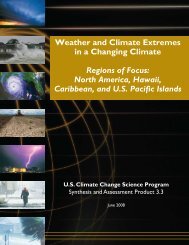Analyses of the Effects of Global Change on - US Climate Change ...
Analyses of the Effects of Global Change on - US Climate Change ...
Analyses of the Effects of Global Change on - US Climate Change ...
Create successful ePaper yourself
Turn your PDF publications into a flip-book with our unique Google optimized e-Paper software.
The U.S. <strong>Climate</strong> <str<strong>on</strong>g>Change</str<strong>on</strong>g> Science Program Glossary and Acr<strong>on</strong>yms<br />
198<br />
T<br />
Technological potential<br />
The amount by which it is possible to create<br />
a reducti<strong>on</strong> in greenhouse gas emissi<strong>on</strong>s<br />
or an improvement in energy efficiency by<br />
implementing a technology or practice that has<br />
already been dem<strong>on</strong>strated.<br />
Technology<br />
A piece <str<strong>on</strong>g>of</str<strong>on</strong>g> equipment or a technique for<br />
performing a particular activity.<br />
Thermal erosi<strong>on</strong><br />
The erosi<strong>on</strong> <str<strong>on</strong>g>of</str<strong>on</strong>g> ice-rich permafrost by <str<strong>on</strong>g>the</str<strong>on</strong>g><br />
combined <str<strong>on</strong>g>the</str<strong>on</strong>g>rmal and mechanical acti<strong>on</strong> <str<strong>on</strong>g>of</str<strong>on</strong>g><br />
moving water.<br />
Thermal expansi<strong>on</strong><br />
In c<strong>on</strong>necti<strong>on</strong> with sea level, this refers to <str<strong>on</strong>g>the</str<strong>on</strong>g><br />
increase in volume (and decrease in density)<br />
that results from warming water. A warming<br />
<str<strong>on</strong>g>of</str<strong>on</strong>g> <str<strong>on</strong>g>the</str<strong>on</strong>g> ocean leads to an expansi<strong>on</strong> <str<strong>on</strong>g>of</str<strong>on</strong>g> <str<strong>on</strong>g>the</str<strong>on</strong>g> ocean<br />
volume and hence an increase in sea level.<br />
Thermohaline circulati<strong>on</strong><br />
Large-scale, density-driven circulati<strong>on</strong> in <str<strong>on</strong>g>the</str<strong>on</strong>g><br />
ocean, caused by differences in temperature<br />
and salinity. In <str<strong>on</strong>g>the</str<strong>on</strong>g> North Atlantic, <str<strong>on</strong>g>the</str<strong>on</strong>g><br />
<str<strong>on</strong>g>the</str<strong>on</strong>g>rmohaline circulati<strong>on</strong> c<strong>on</strong>sists <str<strong>on</strong>g>of</str<strong>on</strong>g> warm<br />
surface water flowing northward and cold<br />
deepwater flowing southward, resulting in a<br />
net poleward transport <str<strong>on</strong>g>of</str<strong>on</strong>g> heat. The surface<br />
water sinks in highly restricted sinking regi<strong>on</strong>s<br />
located in high latitudes.<br />
Threshold<br />
The level <str<strong>on</strong>g>of</str<strong>on</strong>g> magnitude <str<strong>on</strong>g>of</str<strong>on</strong>g> a system process<br />
at which sudden or rapid change occurs. A<br />
point or level at which new properties emerge<br />
in an ecological, ec<strong>on</strong>omic or o<str<strong>on</strong>g>the</str<strong>on</strong>g>r system,<br />
invalidating predicti<strong>on</strong>s based <strong>on</strong> ma<str<strong>on</strong>g>the</str<strong>on</strong>g>matical<br />
relati<strong>on</strong>ships that apply at lower levels.<br />
Time scale<br />
The characteristic time it takes for a process to<br />
be expressed.<br />
Time-series studies 26<br />
Studies d<strong>on</strong>e using a set <str<strong>on</strong>g>of</str<strong>on</strong>g> data that expresses a<br />
particular variable measured over time.<br />
Top-down models<br />
The terms “top” and “bottom” are shorthand for<br />
aggregate and disaggregated models. The topdown<br />
label derives from how modelers applied<br />
macro-ec<strong>on</strong>omic <str<strong>on</strong>g>the</str<strong>on</strong>g>ory and ec<strong>on</strong>ometric<br />
techniques to historical data <strong>on</strong> c<strong>on</strong>sumpti<strong>on</strong>,<br />
prices, incomes, and factor costs to model final<br />
demand for goods and services, and supply<br />
from main sectors, like <str<strong>on</strong>g>the</str<strong>on</strong>g> energy sector,<br />
transportati<strong>on</strong>, agriculture, and industry.<br />
Therefore, top-down models evaluate <str<strong>on</strong>g>the</str<strong>on</strong>g><br />
system from aggregate ec<strong>on</strong>omic variables, as<br />
compared to bottom-up models that c<strong>on</strong>sider<br />
technological opti<strong>on</strong>s or project specific<br />
climate change mitigati<strong>on</strong> policies. Some<br />
technology data were, however, integrated into<br />
top-down analysis and so <str<strong>on</strong>g>the</str<strong>on</strong>g> distincti<strong>on</strong> is not<br />
that clear-cut.<br />
Total cost<br />
All items <str<strong>on</strong>g>of</str<strong>on</strong>g> cost added toge<str<strong>on</strong>g>the</str<strong>on</strong>g>r. The total cost<br />
to society is made up <str<strong>on</strong>g>of</str<strong>on</strong>g> both <str<strong>on</strong>g>the</str<strong>on</strong>g> external cost<br />
and <str<strong>on</strong>g>the</str<strong>on</strong>g> private cost, which toge<str<strong>on</strong>g>the</str<strong>on</strong>g>r are defined<br />
as social cost.<br />
Trade effects<br />
Ec<strong>on</strong>omic impacts <str<strong>on</strong>g>of</str<strong>on</strong>g> changes in <str<strong>on</strong>g>the</str<strong>on</strong>g> purchasing<br />
power <str<strong>on</strong>g>of</str<strong>on</strong>g> a bundle <str<strong>on</strong>g>of</str<strong>on</strong>g> exported goods <str<strong>on</strong>g>of</str<strong>on</strong>g> a<br />
country for bundles <str<strong>on</strong>g>of</str<strong>on</strong>g> goods imported from<br />
its trade partners. <strong>Climate</strong> policies change <str<strong>on</strong>g>the</str<strong>on</strong>g><br />
relative producti<strong>on</strong> costs and may change terms<br />
<str<strong>on</strong>g>of</str<strong>on</strong>g> trade substantially enough to change <str<strong>on</strong>g>the</str<strong>on</strong>g><br />
ultimate ec<strong>on</strong>omic balance.<br />
Transient climate resp<strong>on</strong>se<br />
The globally averaged surface air temperature<br />
increase, averaged over a 20-year period,<br />
centered at <str<strong>on</strong>g>the</str<strong>on</strong>g> time <str<strong>on</strong>g>of</str<strong>on</strong>g> CO 2 doubling (i.e., at<br />
year 70 in a 1 percent per year compound CO 2<br />
increase experiment with a global coupled<br />
climate model).<br />
26 Modified from Millennium Ecosystem Assessment,<br />
2005. “Time-Series Data.”




